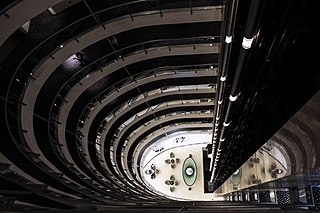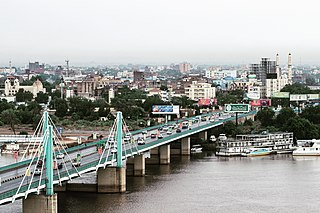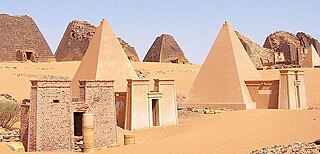
Khartoum or Khartum is the capital of Sudan. With a population of 6,344,348, Khartoum's metropolitan area is the largest in Sudan.

The Nile is a major north-flowing river in northeastern Africa. It flows into the Mediterranean Sea. The Nile is the longest river in Africa and has historically been considered the longest river in the world, though this has been contested by research suggesting that the Amazon River is slightly longer. Of the world's major rivers, the Nile is one of the smallest, as measured by annual flow in cubic metres of water. About 6,650 km (4,130 mi) long, its drainage basin covers eleven countries: the Democratic Republic of the Congo, Tanzania, Burundi, Rwanda, Uganda, Kenya, Ethiopia, Eritrea, South Sudan, Republic of the Sudan, and Egypt. In particular, the Nile is the primary water source of Egypt, Sudan and South Sudan. Additionally, the Nile is an important economic river, supporting agriculture and fishing.

The White Nile is a river in Africa, one of the two main tributaries of the Nile, the other being the Blue Nile. The name comes from the clay sediment carried in the water that changes the water to a pale color.

The University of Khartoum is a public university located in Khartoum, Sudan. It is the largest and oldest university in Sudan. UofK was founded as Gordon Memorial College in 1902 and established in 1956 when Sudan gained independence. Since that date, the University of Khartoum has been recognized as a top university and a high-ranked academic institution in Sudan and Africa.

Sudan University of Science and Technology is one of the largest public universities in Sudan, with ten campuses in Khartoum state. The main campus is located in the so-called Al Mugran area of Khartoum, the confluence of the White Nile and the Blue Nile.
Unity High School is an independent multi-denominational co-educational private school in Khartoum, Sudan, which uses the English language and provides a British-style education to children from 4 to 18 years of age. It opened as an all-girls school in 1902, and in its current form goes back to 1928. Unity High is situated in the center of Khartoum.

Khartoum North, or Khartoum Bahri, is a city in Khartoum State, lying to the north of Khartoum city, the capital of Sudan.
The Mahas are a sub-group of the Nubian people located in Sudan along the banks of the Nile. They are further split into the Mahas of the North and Mahas of the Center. Some Mahas villages are intermixed with remnants of the largely extinct Qamhat Bishari tribe, and as a result today the Qamhat Mahas are ethnic Beja who speak a Nubian language. In the Butana area some Mahas have intermarried with the Rashaida people. The Mahas speak the Nobiin language which is a Northern Nubian language spoken primarily in northern Sudan in Wadi Halfa, they also speak Sudanese Arabic.

The Butana, historically called the Island of Meroë, is the region between the Atbara and the Nile in the Sudan. South of Khartoum it is bordered by the Blue Nile and in the east by Lake Tana in Ethiopia. It should not be confused with the Gezira, the region west of the Blue Nile and east of the White Nile.

The Corinthia Hotel Khartoum is a five-star hotel in central Khartoum, the capital of Sudan, on the meeting point of the Blue Nile and White Nile and in the centre of Khartoum's commercial, business, and administrative districts. It is located next to the Friendship Hall of Khartoum and the Tuti Bridge.

Tuti Island is an island in Sudan where the White Nile and Blue Nile merge to form the main Nile. It is surrounded by the "Three Towns": Khartoum, Omdurman, and Khartoum North. Despite this, Tuti is home to only one small village, with grassland being the main makeup of the island. In the past the only approach to Tuti Island was via several ferries that cross the river intermittently, but the Tuti Bridge, a modern suspension bridge, was completed in 2008 and can be used instead. The island area is 3.99 square kilometres (1.54 sq mi).

Opened in 2007, the El Mek Nimr Bridge links the downtown area of Khartoum, Sudan with the adjacent city of Khartoum North across the Blue Nile river. It is named after Mek Nimr, a leader of the Ja'alin tribe in northern Sudan, who was famously defeated against the Egyptians.
Al Mansheiya Bridge is a bridge that links the capital Khartoum and the industrial city Khartoum North across the Blue Nile in central Sudan.
Kober Bridge is a bridge for road traffic that links the neighbourhood of al-Riadh in Khartoum with Kafouri in the industrial city Khartoum North across the Blue Nile in central Sudan. Named after the adjacent neighbourhood Kober in Khartoum North, it is also called "Armed Forces Bridge" and was opened on 23 October 2014.
The following is a timeline of the history of the city of Khartoum, Sudan.

St. Matthew's Cathedral is a Roman Catholic Christian religious building in Khartoum, which is the capital of Khartoum State and Sudan. The cathedral is located on the bank of the Blue Nile, next to the Mac Nimir Bridge. It is the seat of the archbishop of the Archdiocese of Khartoum, under the patronage of Saint Matthew the Apostle. This building resembles a fairy-tale castle with its various turrets, slender spires and a large rose window.

Daoud Mustafa Khalid was a prominent Sudanese physician and neurologist. He was known as the "founding father of medicine in Sudan''.

The architecture of Sudan mirrors the geographical, ethnic and cultural diversity of the country and its historical periods. The lifestyles and material culture expressed in human settlements, their architecture and economic activities have been shaped by different regional and environmental conditions. In its long documented history, Sudan has been a land of changing and diverse forms of human civilization with important influences from foreign cultures.
Burri Almahas is a neighbourhood located in the state of Khartoum within northern region of the city of Khartoum, and it is one of the old neighbourhoods of Khartoum.













